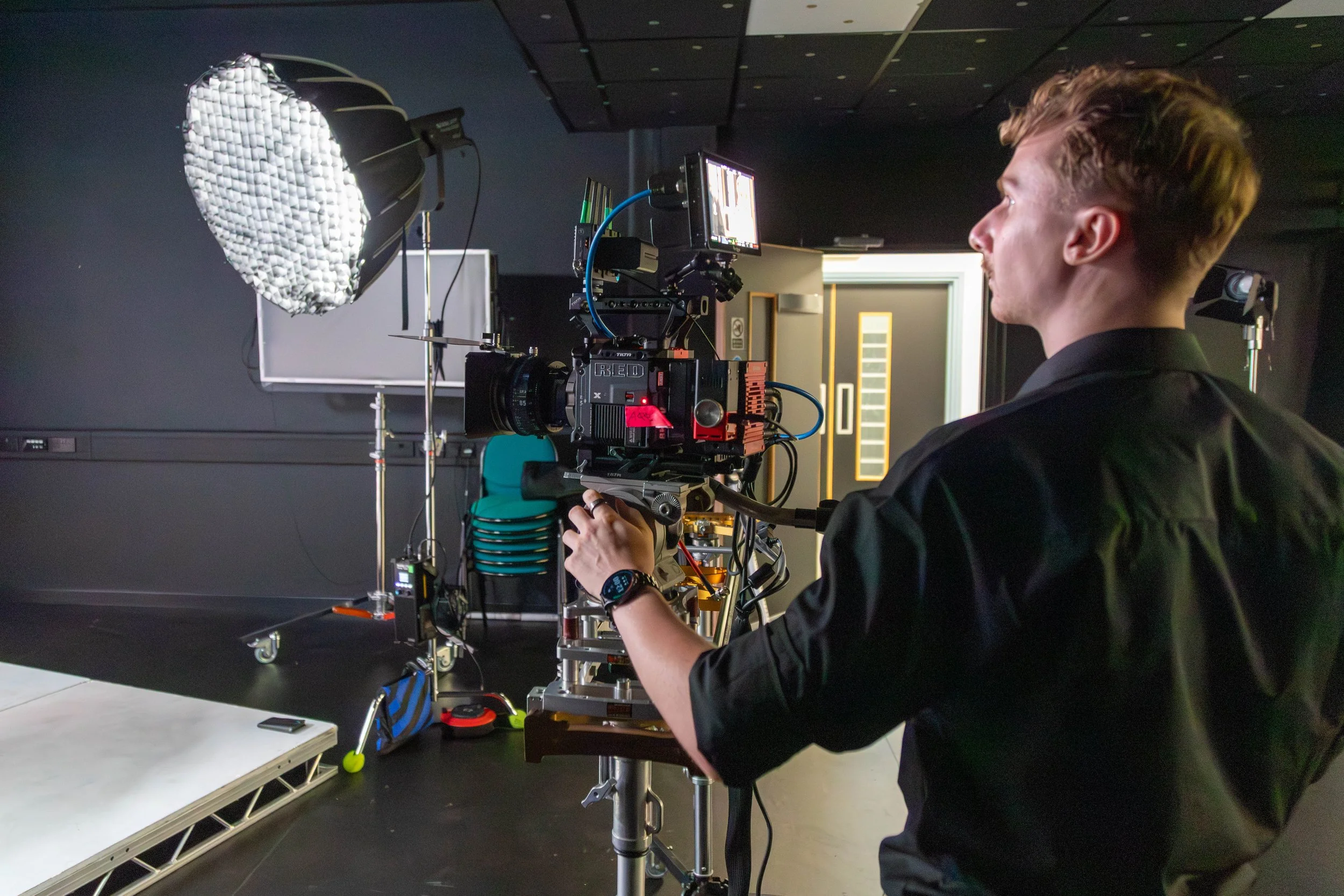The Key Elements of a Successful Business Video Production
How to Craft a Story That Resonates
Relying on static brochures or text-heavy websites is a thing of the past if you want to connect with your audience and drive your business growth. People like stories, visuals, and authenticity. This is why business video production has become one of the most powerful tools for modern marketing and communication. From showcasing a new product to telling the story of a brand’s values, a well-produced video can influence perceptions, boost engagement, and drive measurable results.
Producing a video that genuinely connects with audiences takes more than pointing a camera at a subject. The most effective videos are built on a solid strategy - a foundation of planning, creativity, and storytelling. In this guide, we’ll explore the eight key elements that make business video production successful and explain how to weave in video storytelling for maximum impact.
Why Business Video Production Matters Today
We live in an era where time has become one of the most valuable commodities. People want information quickly and in a form that’s easy to digest. Attention spans are shorter than ever, and demand for engaging content continues to rise. Video isn’t just another marketing trend, as some may think. It’s become the most effective way to deliver messages quickly and memorably. A good business video can:
Convey information in a way that’s easier to understand and retain.
Showcase the human side of a brand, building stronger emotional bonds.
Boost search engine rankings, as video content is increasingly prioritised.
Drive conversions by making complex offers more approachable.
Simply put, investing in business video production isn’t just about staying current; it's about staying ahead and giving your brand a stronger, more relatable voice.
9 Key Elements of Successful Business Video Production:
1. Clear Objectives
2. Understanding Your Audience
3. Storytelling
4. Pre-Production Planning
5. High-Quality Footage
6. Authenticity
7. Branding and Consistency
8. Optimisation for Platforms and SEO
9. Performance Measurement
1. Clear Objectives
Every successful business video starts with a clear purpose. Before filming a single frame, ask yourself: what do I want this video to achieve? Am I aiming to attract new clients, showcase a product, build brand awareness, or provide internal training for staff? The answer to this question will shape every aspect of your video, from the tone and visuals to the messaging and distribution strategy.
Clear objectives do more than guide production; they ensure that your video delivers tangible results. For example, a video created to generate leads will require a strong call-to-action and measurable tracking, whereas a brand-awareness video might focus more on storytelling and emotional engagement. Defining the goal early allows you to make strategic choices that save time, reduce costs, and maximise the impact of your content.
Without a clear objective, even a visually stunning or creatively ambitious video risks missing the mark. Audiences may enjoy watching it, but if the video doesn’t achieve your business goals, the investment won’t deliver a return.
Key Elements of Successful Business Video Production
2. Understanding Your Audience
Every business video production is only as effective as its relevance to the audience. Different groups respond to different tones, visuals, and messaging. A recruitment video aimed at graduates will differ from a corporate training video for senior staff.
Audience research goes beyond demographics. You need to understand their behaviours, preferences, challenges, and aspirations. What motivates them? What questions or objections might they have? What kind of content do they naturally engage with online? Answering these questions ensures your video doesn’t just exist; it resonates.
When your content is tailored to the audience’s expectations and needs, it feels personal, relevant, and trustworthy. This relevance increases engagement, keeps viewers watching longer, and improves the chances of them taking the next step; whether that’s making a purchase, signing up for a newsletter, or sharing your content.
Investing time in audience research may feel like a small step, but it pays off exponentially in the effectiveness of your business video production. After all, even the most beautifully produced video will fall flat if it doesn’t speak directly to the people you want to reach.
3. Storytelling
At the heart of every effective business video is storytelling. Facts and features alone rarely capture attention, but stories do. A narrative helps audiences relate to your message, making it memorable.
Challenge, solution and outcome. This is a simple, three-part structure, which works best. Ask yourself what problem your audience faces. How does your product or service address it? What positive transformation can your prospective clients expect?
A compelling story demonstrates empathy and understanding, showing viewers that your brand understands them. Well-told stories create emotional connections that encourage engagement, loyalty, and trust.
4. Pre-Production Planning
Pre-production is where the foundation of your video is built. Planning here can make or break a project. This stage includes writing and refining the script, creating storyboards and shot lists, scheduling locations, and preparing equipment and crew.
A well-planned video ensures that every shot aligns with your objectives, saving time in post-production and ensuring efficiency throughout the process.
Business Video Shoot
5. High-Quality Footage
In business video production, the smallest details can make a huge difference to how your brand is perceived. Poor lighting, shaky camera work, or muffled sound can instantly undermine even the most compelling story. If the technical quality isn’t there, the message gets lost, and the viewer may question the professionalism of the brand itself.
From using the right equipment and lighting setups to capturing crystal-clear audio, every technical choice needs to be made with your audience in mind. The goal isn’t to be flashy for the sake of it; it’s to create clarity so the viewer can focus entirely on the story being told.
High-quality footage doesn’t just look good; it builds trust. When audiences see a well-produced video, it reassures them that your business takes pride in its work, pays attention to detail, and invests in doing things properly. In many cases, quality is what sets a company apart from its competitors.
6. Authenticity
While professional standards are essential, authenticity is what truly makes viewers lean in. People like connecting with the real people behind the brand.
Behind-the-scenes footage of your team at work, honest interviews with staff, orcase studies often resonate more strongly than scripted recordings. These glimpses into the “human side” of your business create relatability and trust. Audiences want to deal with approachable, passionate, and transparent human beings, not a faceless corporate entity.
7. Branding and Consistency
When your audience sees a video that feels unmistakably like you, it reinforces recognition and trust. From a quick social clip to a longer explainer, every piece of content should look and sound like it comes from the same place. It’s not only about what you say in the video, but also how you say it, the colours, the fonts, the tone of voice, the pacing, and even the music, all play a part in shaping your audience’s perception. That level of alignment fosters familiarity, which is crucial for building brand loyalty.
Logos need to be used thoughtfully, colour palettes need to match your brand guidelines, and the overall tone must reflect your identity.
Strong branding and consistency don’t just make a video look professional; they make it memorable. By looking at your content, people should instantly know it’s yours before they’ve even read the caption or clicked play.
Good audio matters. People will forgive slightly poor lighting, but no one will stick around for bad sound. It physically hurts the watcher. Make sure to stay close to the mic or invest in a wireless mic kit.
8. Optimisation for Platforms and SEO
A business video only achieves its purpose if it reaches the right audience. For that reason, optimisation is a vital step in the process. Each platform has its own format, audience behaviour, and best practices, so tailoring content is essential for visibility and engagement.
Key areas of optimisation include:
Platform-specific formats - i.e., videos designed for LinkedIn and Instagram often require shorter, more focused clips.
Search engine optimisation (SEO), titles, descriptions, and tags should be written with relevant keywords to improve discoverability across search engines and video platforms.
Accessibility - subtitles, captions, and clear visuals make videos more inclusive and ensure the message reaches the widest possible audience.
Social media adaptation - shorter edits or teaser clips help maintain attention spans and increase shareability without losing the core message.
Optimised business video content is easier to find, more likely to be shared, and better equipped to deliver results.
9. Performance Measurement
The true impact of a business video extends far beyond simple view counts. Measuring success requires looking at how the content performs against defined objectives. Engagement levels, such as how long viewers watch and interact, indicate how effectively the video holds attention.
Conversion data, including leads or sales, shows whether the message is driving meaningful action. In addition, website traffic generated from embedded videos provides insight into how the content contributes to wider digital strategies.
By analysing these performance indicators, you can identify strengths, address weaknesses, and refine your approach to your next video projects.
Key Elements of Successful Business Video Production. The Key Takeaways.
A successful business video production is a mixture of art and science. In a world where time is more valuable than ever, videos allow brands to communicate quickly, clearly, and memorably.
By focusing on these nine elements: objectives, audience understanding, storytelling, pre-production, high quality, authenticity, branding and consistency, optimisation, and performance measurement; you can truly resonate with audiences, respect their time, and deliver measurable results.
With the right approach, every video can become a powerful tool to convert viewers into loyal advocates for your brand.
Take the next step in elevating your brand.Partner with Lamplight Media, anaward-winning video production company, to create business videos that captivate, convert, and leave a lasting impact.
FAQs
1. Why is storytelling essential in business video production?
Storytelling creates emotional engagement, makes content memorable, and demonstrates that your brand understands its audience.
2. How long should a business video be?
Most marketing videos perform best under three minutes, though training or educational content may be longer.
3. Can small businesses benefit from professional video production?
Quality videos build credibility, enhance professionalism, and help smaller brands compete effectively.
4. How do we know if a video is successful?
The success of a business video is evaluated against clearly defined objectives using key performance indicators (KPIs) (average watch time and interaction rates, number of leads or conversions, website traffic driven by the video, etc). Tracking these indicators allows businesses to understand the video’s impact, identify areas for improvement, and refine future productions to achieve better results.
5. Should a business video production be tailored for different platforms?
Yes, tailoring length, format, and style for each platform ensures the video performs effectively and reaches audiences where they are most active.
6. What is the lifespan of a business video?
A well-planned business video can stay relevant for years, especially when designed with evergreen content, though trends or product updates may require refreshes.


